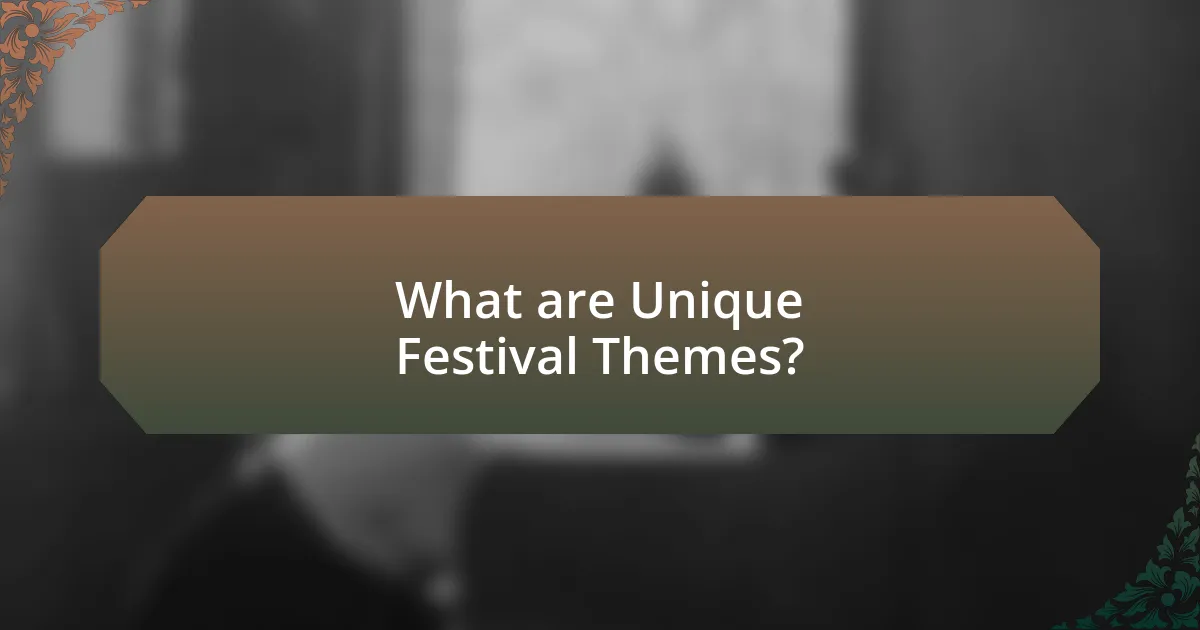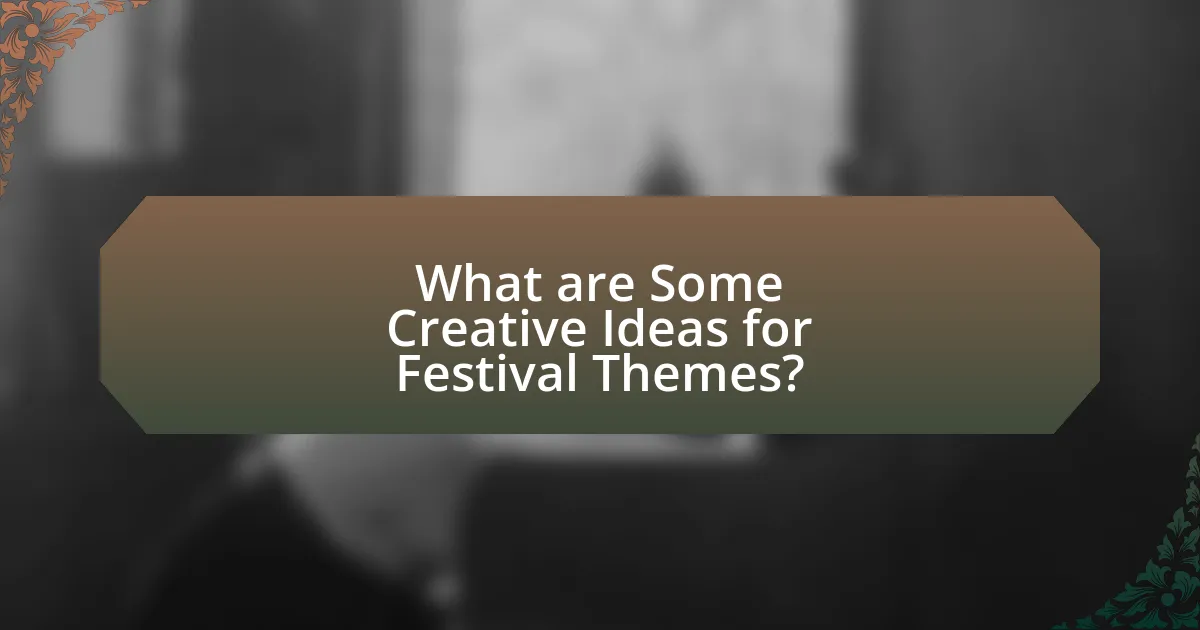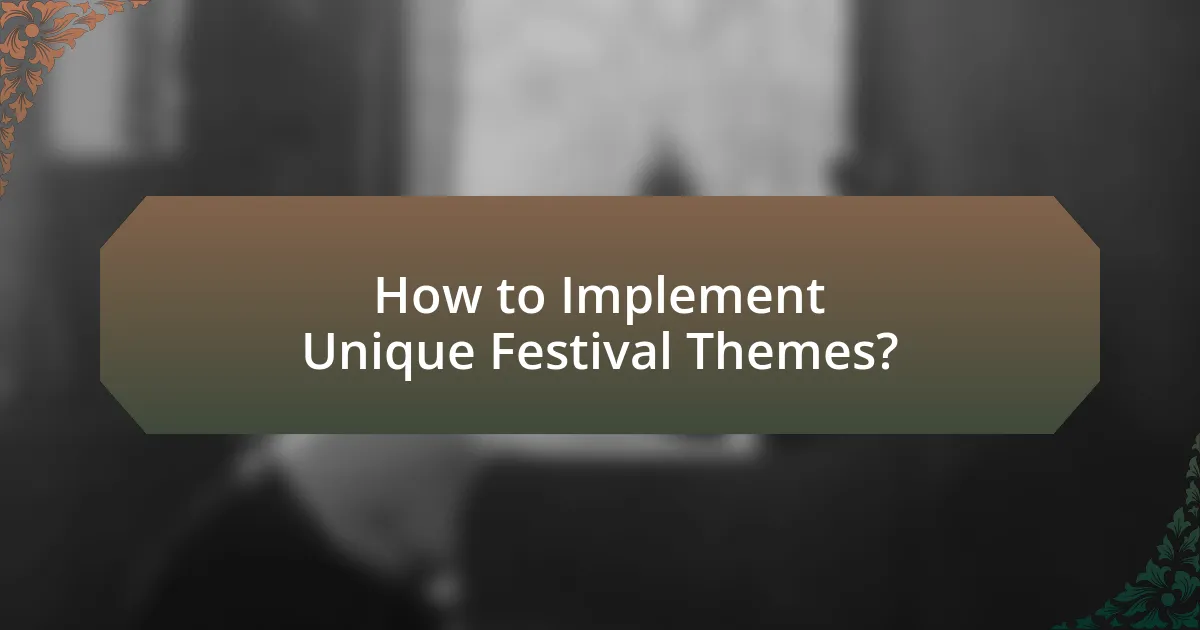The article focuses on the concept of crafting unique festival themes, which are essential for creating memorable experiences that engage attendees. It explores how these themes enhance the overall festival atmosphere through cultural significance, artistic expression, and community involvement. Key elements contributing to a theme’s uniqueness are discussed, along with the importance of local traditions and seasonal influences. Additionally, the article outlines best practices for developing and executing festival themes, including community input, collaboration, and effective marketing strategies, ultimately emphasizing the impact of a strong theme on attendee engagement and satisfaction.

What are Unique Festival Themes?
Unique festival themes are distinctive concepts that define the atmosphere, activities, and overall experience of a festival. These themes can range from cultural celebrations, such as a Renaissance fair, to modern interpretations like a tech festival showcasing innovations. For example, the Burning Man festival features a theme that changes annually, influencing art installations and participant interactions, which enhances the immersive experience. Such themes not only attract diverse audiences but also foster community engagement and creativity, making the festival memorable.
How do unique festival themes enhance the overall experience?
Unique festival themes enhance the overall experience by creating a cohesive atmosphere that engages attendees on multiple sensory levels. These themes provide a framework for activities, decorations, and performances, allowing for a more immersive experience. For instance, a festival themed around a specific culture can incorporate traditional music, food, and art, which not only educates participants but also fosters a sense of community and belonging. Research indicates that themed events can increase attendee satisfaction and participation rates, as they offer unique experiences that stand out from typical gatherings.
What elements contribute to a festival theme’s uniqueness?
A festival theme’s uniqueness is primarily influenced by its cultural significance, artistic expression, and community involvement. Cultural significance ensures that the theme resonates with the values and traditions of the target audience, making it relevant and meaningful. Artistic expression, through visual design, music, and performances, enhances the theme’s appeal and creates a memorable atmosphere. Community involvement fosters a sense of ownership and participation, allowing local traditions and stories to shape the festival, which further distinguishes it from others. For example, festivals like Diwali in India or Carnival in Brazil showcase unique cultural elements that reflect their respective societies, making them stand out globally.
How do cultural influences shape festival themes?
Cultural influences shape festival themes by reflecting the values, traditions, and practices of a community. For instance, festivals often incorporate local customs, historical events, and religious beliefs, which serve as a foundation for their themes. An example is the Diwali festival in India, which celebrates the victory of light over darkness and incorporates themes of family, prosperity, and renewal, deeply rooted in Hindu mythology. Additionally, festivals like Mardi Gras in New Orleans showcase cultural diversity through vibrant parades and music, highlighting the city’s French, Spanish, and African heritage. These elements demonstrate how cultural contexts directly inform the thematic choices of festivals, making them unique and meaningful to their respective communities.
Why is it important to craft a memorable festival theme?
Crafting a memorable festival theme is crucial because it creates a unique identity that distinguishes the event from others. A well-defined theme enhances the overall experience for attendees, fostering engagement and emotional connection. For instance, festivals with strong themes, such as the “Burning Man” festival, attract large crowds and generate significant media attention, demonstrating the impact of a cohesive theme on attendance and visibility. Additionally, a memorable theme can drive marketing efforts, as it provides a focal point for promotional materials and social media campaigns, ultimately leading to increased ticket sales and participant satisfaction.
What impact does a memorable theme have on attendee engagement?
A memorable theme significantly enhances attendee engagement by creating a cohesive and immersive experience that resonates emotionally with participants. When attendees can connect with a theme, they are more likely to participate actively, share their experiences, and form lasting memories. Research indicates that events with strong thematic elements can increase attendee satisfaction by up to 30%, as they foster a sense of belonging and community. This emotional connection encourages attendees to engage more deeply with the event’s activities, leading to higher levels of interaction and enjoyment.
How can a strong theme influence festival branding?
A strong theme can significantly enhance festival branding by creating a cohesive identity that resonates with attendees. This cohesive identity helps to differentiate the festival from competitors, making it more memorable and appealing. For instance, festivals like Coachella utilize a distinct artistic theme that influences their branding, marketing materials, and overall atmosphere, leading to increased brand loyalty and recognition. Research indicates that a well-defined theme can improve audience engagement by up to 30%, as it fosters a sense of belonging and connection among participants.

What are Some Creative Ideas for Festival Themes?
Some creative ideas for festival themes include “Around the World,” which celebrates global cultures through food, music, and art, and “Enchanted Forest,” featuring whimsical decorations and nature-inspired activities. Another theme is “Retro Revival,” focusing on nostalgia with music and fashion from past decades. Additionally, “Futuristic Visions” can explore technology and innovation through interactive exhibits. Each of these themes can enhance attendee engagement and create memorable experiences by immersing participants in unique atmospheres and activities that reflect the chosen concept.
How can seasonal themes be effectively utilized?
Seasonal themes can be effectively utilized by aligning festival activities, decorations, and marketing strategies with the characteristics and emotions associated with each season. For instance, spring themes can incorporate floral decorations and outdoor activities, while winter themes can focus on cozy atmospheres and holiday celebrations. Research indicates that events that resonate with seasonal sentiments can enhance attendee engagement and satisfaction, as seen in festivals like the Cherry Blossom Festival in Washington, D.C., which attracts over 1.5 million visitors annually by celebrating the beauty of spring. By leveraging these seasonal elements, organizers can create memorable experiences that resonate with participants and encourage repeat attendance.
What are examples of successful seasonal festival themes?
Successful seasonal festival themes include “Harvest Festival,” which celebrates the autumn bounty with local produce and crafts, and “Winter Wonderland,” featuring holiday lights and winter activities. The “Spring Fling” theme often highlights blooming flowers and outdoor activities, while “Summer Beach Bash” focuses on beach games and water activities. These themes attract large crowds and foster community engagement, as evidenced by events like the Albuquerque International Balloon Fiesta, which draws over 800,000 attendees annually, showcasing the effectiveness of themed festivals in creating memorable experiences.
How do seasonal themes affect festival planning?
Seasonal themes significantly influence festival planning by dictating the choice of activities, decorations, and overall atmosphere. For instance, a winter festival may incorporate elements like snow-themed decorations, ice sculptures, and holiday music, while a summer festival might focus on outdoor activities, bright colors, and beach-related themes. These seasonal elements not only enhance the festival’s appeal but also align with audience expectations and cultural practices associated with specific times of the year, such as harvest celebrations in autumn or spring flower festivals. This alignment can lead to increased attendance and engagement, as evidenced by studies showing that festivals that resonate with seasonal themes attract larger crowds and foster a sense of community.
What role do local traditions play in theme development?
Local traditions significantly influence theme development by providing authentic cultural elements that enhance the overall experience. These traditions serve as a foundation for creating themes that resonate with the community, ensuring that festivals reflect local values, history, and customs. For instance, incorporating traditional music, dance, and culinary practices into festival themes not only attracts attendees but also fosters a sense of belonging and pride among locals. This connection to heritage can be seen in events like the Albuquerque International Balloon Fiesta, where local Native American culture is celebrated, enriching the festival’s theme and drawing in visitors interested in authentic experiences.
How can local culture be integrated into festival themes?
Local culture can be integrated into festival themes by incorporating traditional customs, local art, and regional cuisine into the festival’s programming. For instance, festivals can feature local musicians and dancers to showcase traditional performances, which not only entertain but also educate attendees about the cultural heritage of the area. Additionally, local artisans can be invited to display and sell their crafts, providing a platform for cultural expression and economic support. Research indicates that festivals that highlight local culture can enhance community pride and attract tourism, as seen in events like the Albuquerque International Balloon Fiesta, which celebrates New Mexico’s unique cultural landscape through art, food, and music.
What are the benefits of highlighting local traditions?
Highlighting local traditions fosters community identity and pride. By showcasing unique cultural practices, festivals can strengthen social bonds among residents, enhance local tourism, and promote economic growth. For instance, a study by the National Endowment for the Arts found that cultural events significantly boost local economies by attracting visitors and supporting local businesses. Additionally, emphasizing local traditions can preserve cultural heritage, ensuring that future generations maintain a connection to their roots.

How to Implement Unique Festival Themes?
To implement unique festival themes, begin by selecting a central concept that resonates with your target audience, such as cultural heritage or environmental sustainability. This concept should guide all aspects of the festival, including decorations, activities, and marketing materials. For instance, if the theme is “Under the Sea,” incorporate oceanic decorations, marine-themed performances, and educational workshops about marine conservation.
Research shows that festivals with cohesive themes enhance attendee engagement and satisfaction; a study by the Event Marketing Institute found that 84% of attendees prefer events with a strong thematic focus. Additionally, collaborating with local artists and businesses can enrich the theme and foster community involvement, making the festival more memorable.
What steps are involved in developing a festival theme?
Developing a festival theme involves several key steps: identifying the target audience, brainstorming theme ideas, conducting research, selecting a cohesive concept, and planning the implementation.
First, identifying the target audience helps to tailor the theme to their interests and preferences, ensuring greater engagement. Next, brainstorming theme ideas encourages creativity and exploration of various concepts that resonate with the audience. Conducting research on successful themes from past festivals provides insights into trends and audience expectations, which can inform the selection process.
After gathering ideas and insights, selecting a cohesive concept is crucial; this concept should unify all festival elements, including decor, activities, and marketing. Finally, planning the implementation involves detailing logistics, budgeting, and resource allocation to bring the theme to life effectively. Each of these steps is essential for creating a memorable and impactful festival experience.
How do you conduct research for theme development?
To conduct research for theme development, one should start by identifying the target audience and their interests. This involves analyzing demographic data, preferences, and cultural trends relevant to the festival context. For instance, surveys and focus groups can provide insights into what themes resonate with potential attendees. Additionally, reviewing successful past festivals and their themes can offer valuable lessons; for example, the Coachella Valley Music and Arts Festival has effectively utilized themes that reflect current cultural movements, which has contributed to its popularity. Furthermore, exploring social media platforms and trend analysis tools can help identify emerging themes and ideas that align with audience expectations. This methodical approach ensures that the developed theme is both engaging and relevant, ultimately enhancing the festival experience.
What tools can assist in the creative process?
Digital tools such as brainstorming software, mind mapping applications, and collaborative platforms can significantly assist in the creative process. These tools facilitate idea generation, organization, and collaboration among team members, enhancing creativity. For instance, platforms like Trello and Asana help in project management and tracking progress, while tools like Miro and MindMeister enable visual brainstorming and mapping of ideas. Research indicates that using collaborative tools can increase creativity by 20% in team settings, as they allow for diverse input and perspectives.
How can collaboration enhance theme creation?
Collaboration enhances theme creation by bringing together diverse perspectives and skills, which fosters innovation and creativity. When individuals from various backgrounds collaborate, they contribute unique ideas and insights that can lead to more original and engaging themes. For instance, a study published in the Journal of Creative Behavior found that teams with diverse members generated more creative solutions compared to homogeneous groups. This diversity in thought can result in themes that resonate more deeply with a wider audience, ultimately creating more memorable experiences at festivals.
What types of partnerships are beneficial for theme development?
Collaborative partnerships with local businesses, artists, and community organizations are beneficial for theme development. These partnerships enhance creativity and resource sharing, allowing for unique and engaging festival themes. For instance, collaborating with local artists can lead to innovative visual designs that reflect the community’s culture, while partnerships with businesses can provide sponsorships and logistical support, ensuring a well-rounded festival experience. Additionally, community organizations can offer insights into local traditions and preferences, further enriching the thematic elements of the festival.
How can community input shape festival themes?
Community input can significantly shape festival themes by incorporating local culture, preferences, and values into the planning process. Engaging community members through surveys, focus groups, or public forums allows organizers to gather diverse perspectives and ideas that reflect the interests of the audience. For instance, festivals that have successfully integrated community feedback, such as the Albuquerque International Balloon Fiesta, often highlight local traditions and themes that resonate with attendees, enhancing participation and enjoyment. This approach not only fosters a sense of ownership among community members but also ensures that the festival remains relevant and appealing, ultimately leading to higher attendance and satisfaction rates.
What are best practices for executing a festival theme?
Best practices for executing a festival theme include thorough planning, cohesive branding, and engaging activities. Thorough planning involves defining the theme clearly and ensuring all elements, such as decorations, performances, and marketing materials, align with it. Cohesive branding ensures that the theme is consistently represented across all platforms, including social media, signage, and merchandise, which enhances recognition and attendee experience. Engaging activities, such as interactive installations or themed performances, create memorable experiences that resonate with attendees, encouraging participation and enhancing enjoyment. These practices are supported by successful festivals like Coachella and Glastonbury, which effectively utilize strong themes to create immersive environments that attract large audiences.
How can you ensure consistency in theme presentation?
To ensure consistency in theme presentation, establish clear guidelines that define the theme’s visual and conceptual elements. These guidelines should include specific color palettes, typography, imagery, and messaging that align with the festival’s overall vision. For instance, a study by the Event Marketing Institute found that 70% of attendees felt more engaged when the event’s theme was consistently represented across all materials, from promotional content to on-site decorations. This consistency reinforces the theme in attendees’ minds, enhancing their overall experience.
What strategies can be used for effective marketing of the theme?
Effective marketing strategies for unique festival themes include leveraging social media platforms, creating engaging content, and utilizing influencer partnerships. Social media platforms like Instagram and Facebook allow for targeted advertising, reaching specific demographics interested in festival experiences. Engaging content, such as videos and interactive posts, can capture audience attention and encourage sharing, increasing visibility. Influencer partnerships can amplify reach, as influencers often have dedicated followings that trust their recommendations, leading to higher ticket sales and attendance. According to a study by the Digital Marketing Institute, campaigns that incorporate social media and influencer marketing can see engagement rates increase by up to 60%.
What tips can help in crafting unique festival themes?
To craft unique festival themes, focus on originality, cultural relevance, and audience engagement. Originality can be achieved by exploring unconventional concepts or merging different cultural elements, which can create a fresh perspective. Cultural relevance ensures that the theme resonates with the target audience, enhancing their connection to the festival. Engaging the audience through interactive elements, such as workshops or participatory art, fosters a deeper experience. For instance, the Burning Man festival exemplifies this by integrating art, community, and self-expression, making it a unique cultural phenomenon.
